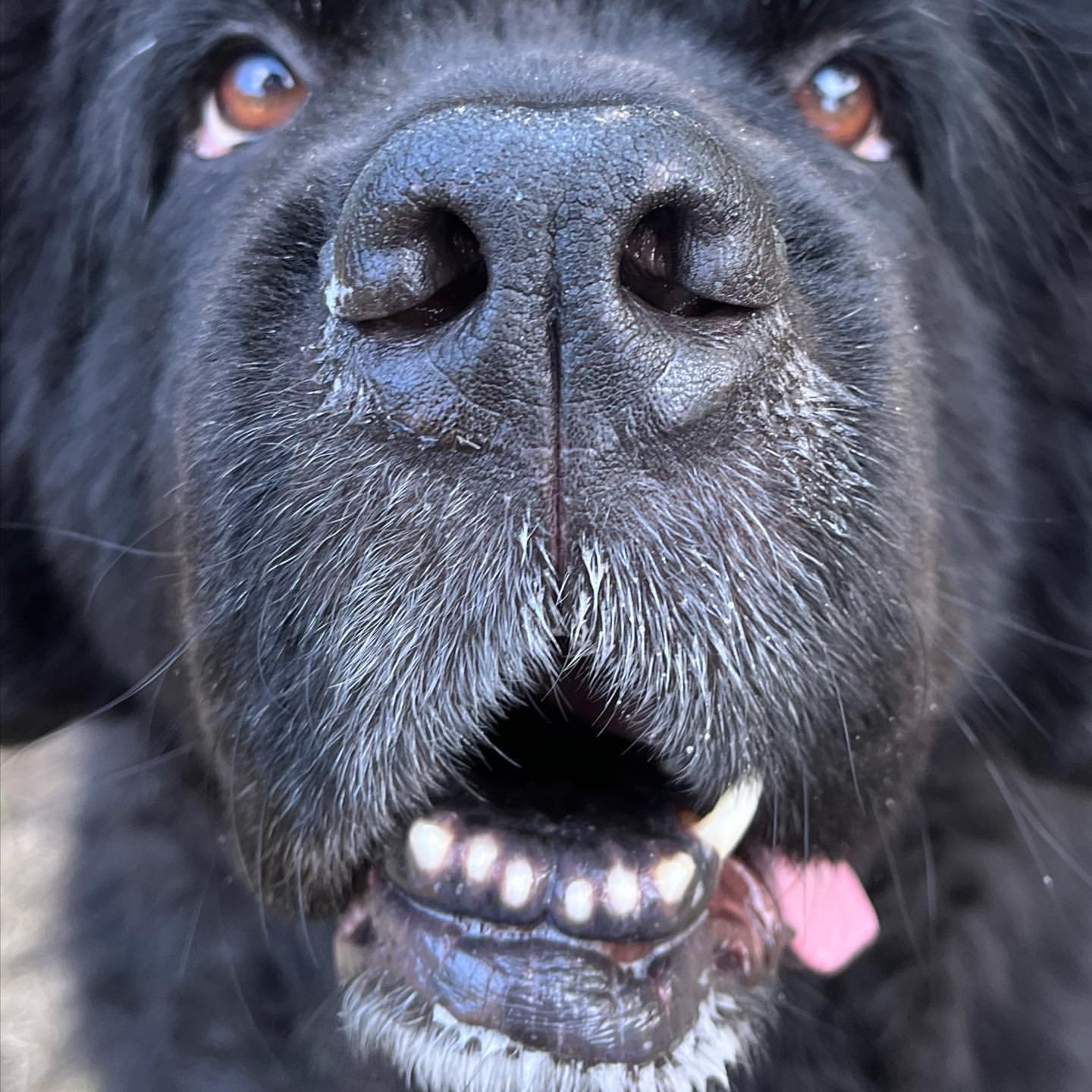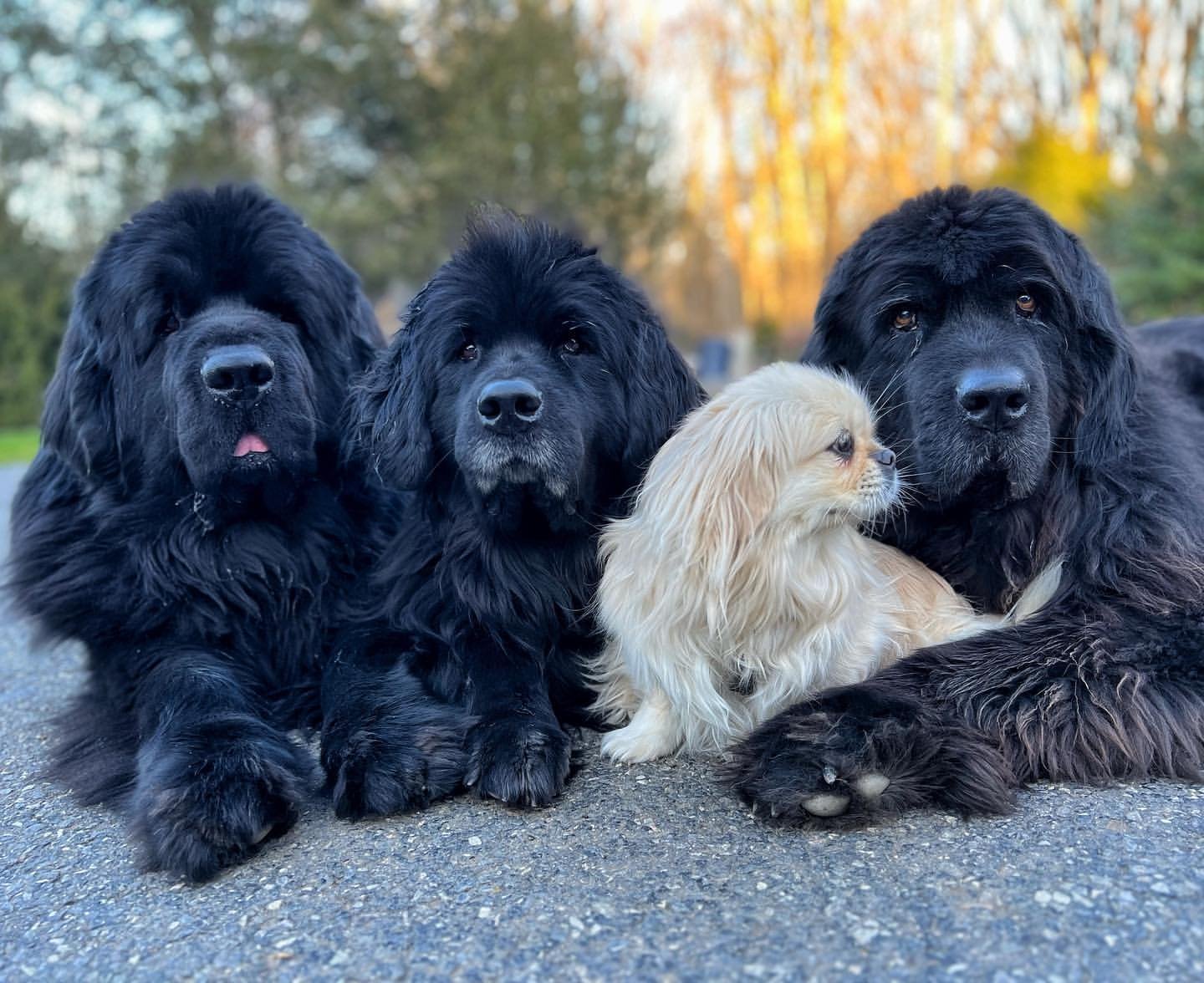Are you interested in knowing about Newfoundland bite force But first, we need to know about the Newfoundland Dog. Newfoundland Dogs are one of the world’s largest and most beloved dog breeds. These dogs are excellent pets and friends for families because of their kind demeanor, intelligence, and loyalty. The Newfoundland is the largest of the working dog breeds and they were originally bred and used in the Newfoundland for pulling nets for fishermen and hauling wood from the forest. They can measure up to 71 cm at the shoulder and weigh can lift up to 80 kg. They are considered one of the largest dog breeds in the world. They are known for being excellent swimmers and have a water-resistant double coat. They help them keep warm in the cold water. Newfoundlands usually like cold weather and do well in it. Their thick coat can cause them to overheat in hot weather so keep outdoor activity short in the heat and make sure your dog always has a place to go to cool down. Newfies generally have a very sweet personality and they love people. They are even typically great around kids. Thanks to their calm and gentle temperament and due to their moderate energy level. They don’t need an excessive amount of exercise but they do enjoy a good walk or play session apart from that they do shed a lot so be prepared for some extra vacuuming and some extra hair on your clothes. In this article, you learn more about the biting force of the Newfoundland Dog breed, Understanding the dynamics of a Newfoundland’s bite force, especially in water, provides valuable insights into their innate strength and capabilities, Newfoundland bite force, shedding light on essential aspects that every dog lover should be familiar with.
How Strong is the Newfoundland Dog Bite Force?
Did you know that Newfoundland dogs have a pretty strong bite? A Newfoundland Dog has a bite force of around 400 pounds per square inch (PSI)! That’s quite a bite force. These dogs are usually about 26 to 28 inches tall and weigh between 100 to 150 pounds. Despite their impressive size and biting power, Newfoundlands are gentle giants who make excellent companions.
So, if you ever get the chance to meet one of these big, lovable dogs, remember that behind that powerful bite is a heart as warm and friendly as can be!
How is Newfoundland Bite Force Measured?
When we talk about bite force, we use something called PSI, which stands for pounds per square inch. It’s like measuring how much biting power is squeezed into every inch of space. Imagine a one-pound weight pushing down on an area the size of a small piece of paper – that’s what PSI measures.
There’s another way to measure bite force called Newtons. It’s a bit different. 1 Newton is like having around 0.22 pounds of bite force. So, if we’re talking about our big and strong Newfoundland Dog with a bite force of 400 PSI, that’s like saying it has about 1779.29 Newtons of biting power. It might sound a bit sciency, but it helps us understand just how strong those furry friends can chomp!
Understanding Newfoundland Bite Force
So, “Newfoundland Bite Force” is basically how strong these fluffy friends can be. Imagine your friend, the Newfoundland, a big, friendly canine.
Have you ever wondered why Newfoundlands have such a strong bite? We’ll look at why they have such powerful jaws and what distinguishes them in terms of biting strength. Hint: It’s not just about their size; there’s more to the story!”
Get a snack and be prepared to learn about Newfoundland dogs and their bites with us!

Research and Measurement
So, scientists wear their lab coats and research the measurement of Newfoundland bite force! They conduct studies and experiments to see how powerful a Newfoundland’s bite can be. It’s like a super cool science project but with our furry pals as the stars!
Now, get ready for the exciting part – the discoveries! Those cool scientists dive into their research and reveal some amazing findings. We’re about to spill the beans on what they’ve learned about how powerful a Newfoundland’s bite can be. Trust us; This is very interesting stuff!
Practical Tips for Everyday Adventures in Newfoundland!
Alright, so we’ve got some cool info about what all this means for you as a Newfoundland dog owner. We’re breaking down the practical side of things, making it easy to understand and apply in your everyday adventures with your furball.
Safety first, right? We’ll dive into some smart precautions to ensure you and your Newfoundland have a blast while staying safe. It’s like having a little safety manual for the best buddy ever!
Being a responsible owner is key. We’ve got some tips on how to rock the role of a Newfoundland parent like a pro. From training to playtime, we’re covering it all in the friendliest way possible!

Do All Newfoundland Dogs Have the Same Bite Force?
So, you’ve heard about the impressive 400 PSI average bite force of Newfoundland dogs, but here’s the scoop: not all Newfies are created equal in the biting department. The thing is, it can vary from dog to dog, and there are a few friendly factors at play.
Size and Strength Matters:
Newfoundlands come in different shapes and sizes. Some are big and brawny, while others might be a bit more petite. It’s like having a diverse group of friends! Males can weigh between 130 to 150 lbs, and females range from 100 to 120 lbs. Now, imagine the variety in muscle mass and bone density – it’s all part of what makes each Newfie unique. From genetics to lifestyle choices like diet and exercise, these contribute to the weight-to-power ratio. Combine a strong physique with a powerful bite, and you’ve got one mighty Newfoundland!
Newfoundland Dog some size guide here!
| Age | Male Weight (lb) | Female Weight (lb) | Height (in) |
| 1 month age | 8 – 12 | 7 – 11 | 10 – 12 |
| 2 months age | 17 – 27 | 15 – 22 | 13 – 14 |
| 3 months age | 41 – 54 | 38 – 46 | 19 – 21 |
| 4 months age | 55 – 65 | 45 – 56 | 20 – 23 |
| 5 months age | 63 – 75 | 54 – 67 | 21 – 24 |
| 6 months age | 73 – 87 | 59 – 72 | 22 – 24 |
| 7 months age | 82 – 98 | 66 – 75 | 22 – 25 |
| 8 months age | 92 – 101 | 69 – 78 | 23 – 25 |
| 9 months age | 102 – 115 | 75 – 84 | 23 – 25 |
| 10 months age | 109 – 121 | 84 – 95 | 24 – 26 |
| 11 months age | 112 – 128 | 92 – 106 | 24 – 26 |
| 12 months age | 114 – 110 | 92 – 110 | 24 – 27 |
| 2 years age | 100 – 120 | 130 – 150 | 27 – 29 |
Age is More Than Just a Number:
Think about it – a little puppy isn’t going to have the same biting power as a full-grown adult Newfoundland. The prime biting years are usually between 3 to 7, and as they gracefully step into their senior years, their strength might take a bit of a dip. It’s just a natural part of the aging process.
Genetics and Anatomy Unraveled:
Now, let’s dive into the science of it all. Genetics and anatomy play a big role – it’s like their unique blueprint. From jaw muscles to joints, teeth, and more, it’s a complex system. The jaw adductor muscles, including the temporal, masseter, medial, and pterygoid muscles, are the key players here. They’re the muscles responsible for eating and chewing, and the temporomandibular joint (TMJ) is their go-to joint. The size and power of these muscles and joints are influenced by the dog’s inherited genetics. So, you can have quite a variety from one Newfie to another – it’s like their own unique fingerprint. Some may even face challenges like muscle injuries or diseases that weaken them over time.

Bite Force of the Newfoundland Dog Compared to Other Breeds
Guess what? Our lovable Newfoundland dog is rocking it on the list of the top 10 dogs known for biting power! And to make it even cooler, the table below breaks down how our Newfie buddies compare to other awesome breeds. It’s like having a sneak peek into the biting superstars’ leaderboard – and our Newfoundlands are right up there!
| Dog Breed | Bite Force PSI |
| Rottweiler | 328 PSI |
| German Shepherd | 291 PSI |
| Cane Corso | 700 PSI |
| Old English Mastiff | 723 PSI |
| Pitbull | 330 PSI |
| Kangal | 734 PSI |
| Doberman | 305 PSI |
| Bullmastiff | 556 PSI |
| Newfoundland dog | 400 PSI |

What are the chances of a Newfoundland Dog biting you?
Wondering about the odds of a Newfoundland Dog giving you a little nip? Well, the good news is that Newfies are known for their gentle and friendly nature! These furry pals are more likely to smother you with slobbery kisses than to nibble on you. They’re big, lovable teddy bears who usually save their strong jaws for playtime and chewing on their favorite toys. So, the chances of a Newfoundland giving you a friendly bite?
Newfoundland Bite Force FAQs
Why Do Newfoundland Dogs Have Strong Bites?
Newfoundland dogs developed powerful bites due to their historical roles as water rescuers and working dogs, demanding significant biting strength for various tasks.
How Strong is a Newfoundland Dog’s Bite Compared to Others?
A Newfoundland’s bite force is around 400 PSI, making them powerful biters. While not the highest, they hold their own against other breeds like Kangals and Cane Corsos.
Do Individual Newfoundlands Differ in Bite Strength?
Yes, variations exist among individual Newfoundlands. Factors like size, genetics, and health contribute to differences in biting strength.
Can Newfoundland Dogs Control Their Bite?
Yes, Newfoundland dogs can control their bite force. Despite powerful jaws, they are generally gentle and can adjust their force based on the situation.
Is a Newfoundland Puppy’s Bite Different from an Adult’s?
Yes, Newfoundland puppies have a less powerful bite than adults. Their jaw strength increases as they grow, and appropriate training is crucial during the puppy stage.
How Should Owners Safely Play with Their Newfoundland Regarding Bite Force?
Owners can engage in safe play using suitable toys that encourage gentle biting. It’s important to avoid games that may trigger aggressive behavior and teach commands like “gentle” during playtime.
Conclusion
So, after this exciting journey through the world of Newfoundland bite force, what’s the scoop? Well, here’s the bark on it:
Our Newfoundland pals, with their mighty 400 PSI bite force, have earned a spot in the top 10 canine biting champions. But hey, not all Newfies are cut from the same chewy cloth. Factors like size, strength, age, and genetics spice up the variety.
But fret not! Despite their impressive size and power, Newfoundlands are more likely to shower you with love than nip at you. These gentle giants are known for their friendly nature and make excellent companions.
And remember, when it comes to measuring bite force, we use something called PSI (pounds per square inch) or Newtons. It might sound a bit sciency, but it’s just a fun way of understanding the jaw power of our furry friends.
So, whether you’re a Newfoundland parent or just a dog enthusiast, understanding their bite force adds a fascinating layer to your appreciation of these lovable furballs. Here’s to the big-hearted Newfoundlands and the joy they bring into our lives! 🐾❤️✨

omnis id quis illum molestias deserunt voluptatem autem dolorum minima sed quia. quod veniam rerum quidem est ipsum sed et corrupti voluptatem dolorum quod tempora officiis et magnam. veniam ea volupt